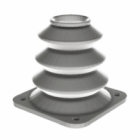Is 3D printing sustainable?
While no manufacturing process is entirely impact-free, 3D printing offers one of the most promising paths toward more sustainable production. It enables digital distribution, localized manufacturing, and material efficiency in ways that traditional processes often can’t. Still, answering the question “Is 3D printing sustainable?” requires looking deeper than surface-level assumptions.
It’s not just about waste reduction — sustainability also depends on energy consumption, materials used, how the technology is applied, and what happens to parts at the end of their lifecycle. This chapter explores those dimensions and the role responsible operation plays in unlocking the full environmental value of additive manufacturing.
How energy consumption shapes sustainability?
3D printing shifts energy usage from centralized industrial plants to decentralized machines — a net positive in many cases. But some printers, particularly those using resin, powder, or metal technologies, can be energy-intensive per part, especially when heating elements or curing systems are involved.
Whether 3D printers are environmentally friendly often depends on the energy source. A printer powered by renewables will naturally have a lower footprint than one running on fossil-based electricity. Overall, additive manufacturing reduces process complexity, which in turn can lower indirect energy costs related to tooling and warehousing.
Material sourcing and recyclability
Material sustainability is just as important as machine efficiency. PLA, a bio-based filament, is widely seen as eco-friendly, though its industrial compostability remains limited. Engineering-grade polymers, resins, and powders offer great performance but may be less recyclable without specialized infrastructure.
Efforts are growing around closed-loop systems, in which leftover powder or failed prints are reclaimed and reused. The more circular the material flow, the more accurate it is to say 3D printing is eco-friendly in practice, not just in principle.
Lifecycle thinking: from cradle to grave
Sustainability goes beyond the print process itself. A printed part’s full environmental impact includes raw material sourcing, energy use during fabrication, operational lifespan, and end-of-life handling.
3D printing contributes positively when used to create lighter structures (e.g. in aerospace), extend product life through replacement parts, or enable on-demand, low-volume manufacturing that avoids overproduction. In these scenarios, 3D printing is sustainable not just technically, but strategically.
Why is the way you print just as important?
Just as important as the technology is how it’s used. A printer producing short-lived novelty items with high support waste is very different from one creating durable, functional parts that displace more resource-intensive alternatives.
The key question isn’t just “Is 3D printing bad for the environment?” — it’s how thoughtfully is it being applied? Responsible practices such as printing only when needed, choosing recyclable materials, and optimizing support usage significantly improve sustainability outcomes.
The bottom line
So, are 3D printers sustainable? Yes — when used with intention, supported by smart material choices and efficient design. The technology offers real potential to reduce environmental impact, especially in low-volume, customized, or distributed manufacturing contexts.
With thoughtful implementation, 3D printing isn’t just a greener alternative — it’s a foundation for rethinking how products are made, consumed, and sustained in a more circular economy.
Explore also
- 3D printing waste
- Is 3D printing bad for the environment?
- 3D print recycling
- Sustainable 3D printing materials
- 3D printing environmental impact
Related categories













